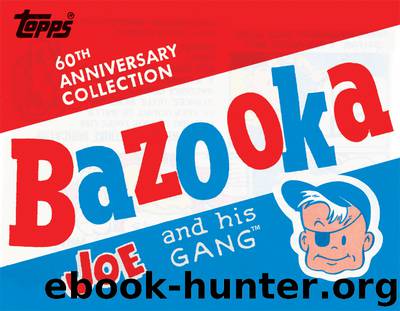Bazooka Joe and His Gang by The Topps Company

Author:The Topps Company
Language: eng
Format: epub
Publisher: Abrams ComicArts
Published: 2013-03-22T04:00:00+00:00
Chicago’s Williamson Candy Co. produced the Amos ‘n’ Andy bar during the 1930s, and Howdy Doody hustled the Mars coconut bar in the early 1950s. The Popsicle, invented in 1922 by Frank Epperson, was adopted as an Eighth Air Force icon during World War II (possibly because of the Popsicle’s resemblance to the two side-by-side bombs clutched in the talons of the eagle insignia familiar to Bombardment Group fliers and ground crews). Actually, what Epperson first invented was the Epsicle, created accidentally when he left a glass of lemonade with a stirring stick in it on an open windowsill during a record-low night in San Francisco. When he changed the “Ep” to “Pop” at the insistence of his children, the Popsicle was born. The five-cent twin Popsicle (two sticks frozen in the paper wrapper) was developed with the notion of sharing: A buyer could break it in half and give the other half to a friend. During the Depression some merchants raked in extra pennies by selling each half for three cents. The twin Popsicle was eventually replaced by a one-stick version in 1986, a response by Popsicle Industries to mothers who found the twin Popsicle “messy.” Although adults consume 50 percent of all Popsicle products, it seems small children couldn’t lick the twin pop fast enough to keep it from dripping. Soon the twin pop will be forgotten, just like Popsicle Pete, the character the Joe Lowe Corporation used to promote the product in the Popsicle Pete Fun Book (1947) and Popsicle Pete Adventure Book (1948).
During that same postwar period, Topps kept gum chewers reading with reprints of many Fawcett/DC Comics filler cartoon strips by Henry Boltinoff, Harry Lampert, and other cartoonists. In addition to these reprints, Topps introduced its own characters in the numbered “Bazooka Comic” series. Art Helfant (1898-1971), who drew filler strips for more than a dozen different comic book publishers during the 1940s, launched the Bazooka Comic series with Bubbles, a four-panel strip about a tiny, mustachioed, balding guy in oversized trousers. By Bazooka Comic no. 22, Bubbles was replaced with another four-panel strip, Rollo. Rollo, a blond, fat kid described as a “sissy” by one of the other kids, soon left in search of more doughnuts. Still fine-tuning by Bazooka Comic no. 31, Topps decided an “Atom Bubble Boy” named Bazooka was the best plan of action to promote the Atom Bubble Cum. In 1949, eighteen million National/DC Comics readers saw Bazooka (the boy) in a full-page ad series that ran in twenty-nine DC titles. Bazooka (the boy) helped other kids, solved crimes, and captured wrongdoers in aerial antics made possible by blowing giant bubbles. No need to toss out ballast. For a descent, Bazooka (the boy) simply announced the astern phrase “Akoozab! Akoozab! And down I go!” And down he went.
The product was, as Topps touted it in Chain Store Age, “an honest nickel’s worth for America’s kids!” Fondling the crinkly foil wrap of the Atom Bubble Gum, one knew the promised science-fiction future had arrived at last.
Download
This site does not store any files on its server. We only index and link to content provided by other sites. Please contact the content providers to delete copyright contents if any and email us, we'll remove relevant links or contents immediately.
Warriors (9781101621189) by Young Tom(10742)
Red Rising by Pierce Brown(8609)
Dresden Files 01 - Storm Front by Jim Butcher(5065)
Enders Game 5 - Ender's Shadow by Orson Scott Card(4468)
Guilty Pleasures by Laurell K Hamilton(4360)
The Dresden Files Omnibus (1-15) by Jim Butcher(3997)
The Heroin Diaries by Nikki Sixx(3494)
Drawing Cutting Edge Anatomy by Christopher Hart(3454)
A Stormy Greek Marriage by Lynne Graham(3383)
The Boy, the Mole, the Fox and the Horse by Charlie Mackesy(3000)
Sharp Objects: A Novel by Gillian Flynn(2956)
Slugfest by Reed Tucker(2942)
11/22/63: A Novel by Stephen King(2912)
The Complete Persepolis by Marjane Satrapi(2863)
The One Memory of Flora Banks by Emily Barr(2803)
Men at Arms by Terry Pratchett(2784)
Grumpy Cat by Grumpy Cat(2688)
Altered Carbon (Takeshi Kovacs Novels) by Richard Morgan(2654)
The Twelve-Month Marriage Deal by Margaret Mayo(2606)
